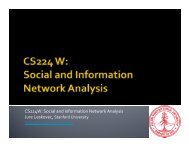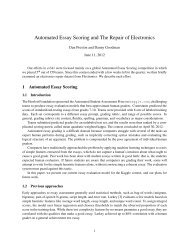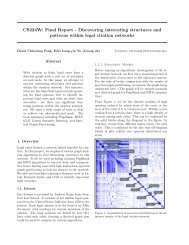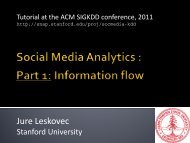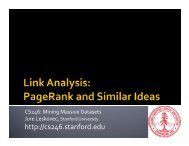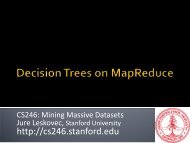Small World Overlay Networks - SNAP
Small World Overlay Networks - SNAP
Small World Overlay Networks - SNAP
You also want an ePaper? Increase the reach of your titles
YUMPU automatically turns print PDFs into web optimized ePapers that Google loves.
Kamil Pawlowski CS224w<br />
Symphony & <strong>Small</strong> <strong>World</strong>s as <strong>Overlay</strong> <strong>Networks</strong><br />
CS224w Final Report<br />
Kamil Pawlowski (kamilp@stanford.edu)<br />
12/11/11 Page 1 of 19
Kamil Pawlowski CS224w<br />
Contents<br />
Contents................................................................................................................................................................. 2<br />
Introduction.......................................................................................................................................................... 4<br />
Motivation............................................................................................................................................................. 4<br />
Prior Work............................................................................................................................................................ 6<br />
Klienberg (2006)............................................................................................................................................... 6<br />
Clauset and Moore (2003) & Sandberg and Clarke(2008) ........................................................................... 6<br />
Chord (Stoica) 2001 ......................................................................................................................................... 6<br />
Symphony (Manku) 2003.................................................................................................................................. 6<br />
Experiment ........................................................................................................................................................... 7<br />
Symphony Configuration.................................................................................................................................. 9<br />
Topologies Under Test ................................................................................................................................... 10<br />
Large Switch Data Center ......................................................................................................................... 10<br />
<strong>Small</strong> Switch Data Center ......................................................................................................................... 10<br />
<strong>Small</strong> Random Graph ................................................................................................................................ 10<br />
Large Random Graph ................................................................................................................................ 10<br />
CAIDA Router Topology Graph .............................................................................................................. 10<br />
Expected Results ............................................................................................................................................. 11<br />
Results.................................................................................................................................................................. 11<br />
Average Path Between Base Nodes.......................................................................................................... 11<br />
Average Path Between Lattice Nodes ...................................................................................................... 12<br />
Average BFS Path On Ring ...................................................................................................................... 12<br />
Average Symphony Path On Ring............................................................................................................ 12<br />
Average Path Between Ring Nodes in Base Graph................................................................................. 12<br />
Average Total Path Length (BFS) ............................................................................................................ 12<br />
Average Total Path Length (Symphony) ................................................................................................. 12<br />
Analysis................................................................................................................................................................ 12<br />
Verification of Ring Construction.................................................................................................................. 12<br />
Verification of Thesis...................................................................................................................................... 13<br />
Ordered vs. Random.................................................................................................................................. 13<br />
Random Graphs vs. Trees ......................................................................................................................... 14<br />
Path Length as a Heuristic for Total Symphony Path Length ................................................................ 14<br />
Performance on the Internet Graph .......................................................................................................... 16<br />
Additional Observations............................................................................................................................ 16<br />
Conclusions and Future Work ........................................................................................................................ 17<br />
References ........................................................................................................................................................... 18<br />
Appendix 1: Running the Software................................................................................................................. 19<br />
12/11/11 Page 2 of 19
Kamil Pawlowski CS224w<br />
Appendix 2: Raw Experimental Results ........................................................................................................ 19<br />
12/11/11 Page 3 of 19
Kamil Pawlowski CS224w<br />
Introduction<br />
This paper presents an experiment in running small world rings (specifically Symphony)<br />
as overlay networks on top of various base graphs/networks. The aim of the experiment<br />
is to characterize the behavior of small world rings in terms of the graphs on which they<br />
are overlaid. The over arching goal of the experiment is to gain an understanding of the<br />
applicability of small world rings in real world scenarios.<br />
In the model used by this paper nodes in the base network are said to host nodes that<br />
belong to the small world ring overlaid on top of it. Nodes in the small world ring<br />
maintain their own links (edges), but those links run over the underlying base graph.<br />
Thus navigating along the small world ring means visiting all of the base graph nodes<br />
that carry those particular ring edges. The specific focus of this paper is the number of<br />
base graph nodes that must be visited when traversing the small world ring. Shorter total<br />
paths are considered superior. This is sometimes referred to as having lower latency, or<br />
shorter distance.<br />
This paper finds that if host nodes are chosen at random, assigning small world nodes to<br />
those host nodes so that base graph distance between adjacent small world nodes is<br />
minimized, results in shorter paths than when the host node to small world node<br />
assignment is random.<br />
This paper finds that small world rings overlaid on top of data center like tree graphs<br />
have shorter total paths than those overlaid on top of random graphs, and Internet like<br />
graphs.<br />
This also paper finds that when a routing operation is performed on the overlaid ring a<br />
reasonable heuristic exists for the number of base graph nodes that are traversed during<br />
this operation. This heuristic is:<br />
AveTotalPathLength ! AvePathLength BaseGraph " AvePathLength <strong>Small</strong><strong>World</strong><strong>Overlay</strong>Graph<br />
Finally the paper finds that time it takes to route a message around the ring is too large for<br />
main line data center applications, and that small world rings are more likely to be useful<br />
as command and control infrastructure in datacenters.<br />
Motivation<br />
Much of today’s most widely used software runs on large clusters of computers hosted in<br />
enormous data centers. This includes everything from Gmail, to Facebook, to Amazon’s<br />
Elastic Cloud (EC2 – where the datacenter is the application). Systems such as these are<br />
required to be both responsive and robust. That is, they must respond to user actions<br />
quickly, and they must be available all the time. In such systems a good deal of thought,<br />
time, and money is spent on performance. However, just as many resources, if not more,<br />
are spent on banal operational tasks required to provide availability. This includes<br />
everything from provisioning new systems, to software configuration, to replacing<br />
12/11/11 Page 4 of 19
Kamil Pawlowski CS224w<br />
hardware when a fan fails. It has been the author’s experience when working for Good<br />
Technology/Motorola, that operational costs of a system, especially due to salaries of<br />
datacenter employees, can eclipse hardware costs in data center applications. Thus<br />
software architectures that are fast, highly resilient to failure, and easy to maintain are<br />
highly attractive in large datacenters.<br />
<strong>Small</strong> world networks built on one-dimensional lattices (rings) offer two principle<br />
features: as we saw in assignment 1, they are highly robust in the face of link failure; and<br />
they offer polylogarithmic routing performance [1]. Symphony [2] provides a small<br />
world that can be bootstrapped quickly and handles the arrival and departure of nodes<br />
from the ring without impacting routing performance. Thus small world networks offer<br />
fast routing and high failure resistance. Symphony is even more attractive as an<br />
architecture for use in large datacenters. Nodes can arrive and depart without impacting<br />
performance, so they can be taken out of service for maintenance or upgrade without<br />
impacting the user experience. Further, capacity can be added without user impact. This<br />
simplifies or obviates a large number of common, but often complex, scenarios that keep<br />
operations teams sweating.<br />
Having shown how attractive a small world ring network can be, consider its construction.<br />
If one attempts to build a small world ring, in practice, it has to be implemented as an<br />
overlay network on top of other physical (or logical) infrastructures. It is not practical or<br />
cost effective to build a physical small world ring because of the probabilistic nature<br />
layout of shortcut (aka long) links. When nodes are added to or removed from the ring,<br />
the shortcut links must be re-balanced. In practice this requires laying out additional cable<br />
when the topology changes, or building a vastly over provisioned underlying<br />
infrastructure. (For the purposes of this discussion setting up short cut links as some<br />
kind of virtual circuits on an Token [3] or FDDI [4] ring counts as building an overlay<br />
network). Thus in practice small world rings must be constructed as overlays.<br />
This having been said, overlay ring networks such as Chord [5] (an inspiration for<br />
Symphony) suffer from well-known issues with respect to the heterogeneity of nodes<br />
and links as well as with distance between nodes. Specifically, the performance of<br />
operations on a ring can be inconsistent because: some nodes are more powerful than<br />
others; some nodes are on higher bandwidth/lower latency links; some nodes that are<br />
adjacent from the point of view of the ring are very far apart in the underlying network. In<br />
each case, the performance of the ring is adversely affected because either, the node or the<br />
network inhibits the rate of flow of messages to be forwarded (routed).<br />
<strong>Small</strong> world rings have considerable advantages. When implemented as overlay networks<br />
they potentially have serious drawbacks as well. How serious are these drawbacks? This<br />
paper seeks understand the impact of the underlying network topology on the<br />
polylogarithmic routing guarantee provided by a small world ring. The goal is to form an<br />
intuition regarding the suitability of small world rings in large-scale data center<br />
12/11/11 Page 5 of 19
Kamil Pawlowski CS224w<br />
environments. Chord and Symphony originated as ideas for Internet scale Distributed<br />
Hash Tables. They were intended to provide search infrastructure for large peer-to-peer<br />
networks. A secondary goal is to determine how a small world ring performs when<br />
overlaid over the Internet.<br />
Prior Work<br />
Klienberg (2006)<br />
Klienberg [1] provides theoretical background for a small world graphs. The paper<br />
provides a loose but consistent definition of a small world network: “when all (or most)<br />
pairs of nodes are connected by paths that are polylogarithmic in n”. It also provides the<br />
theorems that form the backbone of the small world construction used in symphony. For<br />
example: if, for k ! 3 , all nodes in a [n node] graph have a degree of k there is a high<br />
probability there will be a path of length O( logn)<br />
. Similarly Klienberg discusses<br />
decentralized search, as the model used in Milgram’s original experiment, and the<br />
theoretical limits on that search. Finally, Klienberg lists the evolution of graphs into<br />
small world networks as an open problem.<br />
Clauset and Moore (2003) & Sandberg and Clarke(2008)<br />
Both of these papers [7] [8] attempt to provide mechanisms by which a small world<br />
network can arise from a graph, or by which it can be maintained. In each case, the time<br />
it takes for the algorithms to converge to a small world ring is significant enough to<br />
preclude it from being used in practice. Further, in both cases, the worst-case search<br />
performance is O(n) . This does not meet the standards for small world graphs.<br />
Chord (Stoica) 2001<br />
Chord [5] is the original distributed hash table paper. It describes a ring-based system<br />
where requests are forwarded from one node to the next, using long links to obviate an<br />
O( n)<br />
search. However Chord is very fragile in relation the arrival and departure of<br />
nodes. Chords has other issues as well, such as the authors recommending that multiple<br />
nodes be run on one system, so that there will be enough nodes in the ring to ensure a<br />
good distribution of keys. While brilliant, it is not practical.<br />
Symphony (Manku) 2003<br />
Symphony [2] is a distributed hash table protocol built on top of a Klienberg style small<br />
world ring. The authors have taken great care to provide a ring that is able to handle the<br />
arrival and departure of nodes. Further, they provide experimental evidence showing<br />
their system in action. Of particular interest in the context of this paper is the fact that the<br />
ring can, and does, grow or shrink. The behavior is shown in their results. In contrast<br />
with the Clauset and Sandberg papers the construction in the Symphony paper is<br />
practical. One can imagine it being deployed in the real world. This is why it forms the<br />
basis for the experiment in this paper.<br />
12/11/11 Page 6 of 19
Kamil Pawlowski CS224w<br />
Experiment<br />
A small world network (ring or graph) is implemented as an undirected overlay on top of<br />
some underlying (undirected) network (graph). Nodes in the underlying graph are said to<br />
host nodes that make up the overlaid small world ring. In this experiment, the goal is to<br />
determine the impact of the structure of the underlying network on the routing<br />
performance of the overlaid small world network. The routing performance (or path<br />
length, latency) is defined to be the path length in the base graph when routing is done<br />
between nodes in the overlaid graph.<br />
To this end a symphony ring is overlaid on a variety of different underlying topologies.<br />
Symphony is used because it is both a small world ring (under the Klienberg definition),<br />
and has the ability to handle the arrival and departure of nodes. This means it has the<br />
routing speed and resilience of a small world ring and also the operational properties that<br />
make it worthwhile to use en vivo. It is an ideal candidate to evaluate for deployment.<br />
The properties of the overlaid ring are kept constant throughout the experiment.<br />
Not all of the nodes in the underlying network are used in the overlaid ring. Which ones<br />
are used depends on the topology under test. Once the underlying nodes that will host the<br />
ring are selected, they are joined to form the lattice. Two different mechanisms are used<br />
to select which nodes are adjacent: proximity and randomness. These represent two real<br />
world cases: preplanning and organic growth. The preplanned case represents<br />
applications as they might come out of the box, with an engineer optimizing for<br />
efficiency. The organic growth case, simulates both expansion of an existing system, as<br />
well as what happens as systems are maintained – it is very difficult to keep them<br />
organized because failures are random.<br />
In the first case, proximity, after the host nodes are chosen, overlay nodes are assigned to<br />
them so that overlay nodes that are adjacent in the lattice have the smallest possible base<br />
path between them. Practically: of the underlying graph nodes chosen to host the ring,<br />
one is selected to host the first overlay (lattice) node. The next node selected is, of the<br />
nodes chosen to host the ring, the one that is closest (as determined by BFS) to the first.<br />
The two hosted nodes are then linked by an edge that makes up part of the lattice. (No<br />
edges are added to the underlying graph). Subsequent nodes are chosen the same way.<br />
No underlying node can host more than one overlay nodes, so no repetition in selection is<br />
permitted. This does mean that the last edge added to the lattice can be longer than<br />
desired, but alternate construction mechanisms would be prohibitively long for the scope<br />
of this experiment.<br />
In the second case (randomness), after host nodes are chosen, the assignment of overlay<br />
nodes to them is done at random, without repetition, until they have all been used. The<br />
lattice is built as before with overlay nodes being linked together as they are added.<br />
12/11/11 Page 7 of 19
Kamil Pawlowski CS224w<br />
This construction results in two different tests for each topology: one dubbed “ordered”<br />
where the ring lies on shortest paths, and one dubbed “random” where the underlying<br />
path length is unknown. When the lattice is in place, the Symphony long link algorithm<br />
is run on each node in the lattice to generate the long links required for a small world ring.<br />
When the ring is in place, a number of measurements are made for each topology.<br />
Whenever a reference is made to an overlay graph, below, it is referring to a Symphony<br />
ring that has been built on top of some underlying graph. The measurements include:<br />
The clustering co-efficient of the nodes in the base (underlay) graph.<br />
The average distance between nodes in the base (underlay) graph.<br />
The average distance between nodes in the overlay graph (without long links)<br />
The average distance between nodes in the overlay graph (with long links, as<br />
computed by Breadth First Search - BFS)<br />
The average small world distance between nodes in the overlay graph (with long<br />
links, as computed by the algorithm described in the Symphony paper)<br />
The average underlying distance between overlaid nodes<br />
The average distance in terms of underlaid nodes in an overlaid path computed<br />
with BFS.<br />
The average distance in terms of underlaid nodes in an overlaid path computed<br />
with the algorithm described in the Symphony paper.<br />
In these last two cases, this means that a path along the ring is computed using either BFS<br />
or Symphony as the search algorithm. Then for each hop in this path the BFS distance is<br />
computed in the underlay graph. For example if overlay node A is hosted by underlay<br />
node 1 and overlay node B is hosted by underlay node 10, then assuming that A and B are<br />
adjacent in the overlay graph, a computation of the path cost from A to B would consist<br />
or running a BFS between node 1 and 10.<br />
In general trials that require the computation of an average, pick 1% of the nodes in the<br />
graph at random, and compute the average distance between those nodes and all other<br />
nodes in the graph. This is done to speedup the experimental process.<br />
Trials for each graph are repeated five times and an average is taken, as there is a large<br />
amount of randomness in choosing the inputs.<br />
The experiment is implemented in Java, using:<br />
bash-3.2$ java -version<br />
java version "1.6.0_26"<br />
Java(TM) SE Runtime Environment (build 1.6.0_26-b03-384-10M3425)<br />
Java HotSpot(TM) 64-Bit Server VM (build 20.1-b02-384, mixed mode)<br />
In a number of cases, to improve the performance of the system, batch BFS computations<br />
are used. This means that a single BFS is given multiple destination nodes for a single<br />
12/11/11 Page 8 of 19
Kamil Pawlowski CS224w<br />
source, and, for example, distances are computed and aggregated for all of them in one<br />
call.<br />
Symphony Configuration<br />
The symphony small world system is configured with k=1 (this gives polylogarithmic<br />
performance, and is equivalent to other small world configurations seen in research<br />
papers). Note that in symphony k is the number of long distance links, where as in a<br />
small world graph k is the degree of each node in the ring. In the lattice being used for<br />
this experiment k=3 (two links to adjacent nodes, and 1 long distance link). To<br />
disambiguate these two configurations this paper refers to k in a small world system as<br />
ksw and k in symphony as ksymph . It should also be noted here that there is a specific<br />
fundamental difference between symphony and the Newman-Watts model [9]. The<br />
Newman-Watts model has random links added to random nodes with a probability p,<br />
while the symphony model has ksymph links added to each node. These links chose their<br />
destinations from a specific probability distribution. The symphony definition of a<br />
small world graph is inline with the Klienberg definition.<br />
Symphony proposes that a look ahead be implemented to speed up the search process.<br />
This is not used because it violates the local routing principle that is fundamental to small<br />
world networks.<br />
As small world networks are described in the literature as undirected, the overlay<br />
networks in the experiment are also un-directed. The underlying network is undirected as<br />
well.<br />
Symphony rings are created via a very specific construction protocol that is run as nodes<br />
are added. This includes both a mechanism to estimate ring size, and a re-linking protocol<br />
to re-distribute links as the ring grows. The aim is to maintain a certain distribution of<br />
links as the ring grows or shrinks in size. Given that the ring sizes are known ahead of<br />
time, this experiment does not use these [Symphony] protocols. Rather it assumes that<br />
the ring has been relinked perfectly when the last node is added. This significantly<br />
simplifies the code used to construct the ring. Further, this does not compromise the<br />
efficacy of the experiment, as the results in the symphony paper make use of a less<br />
perfectly relinked ring.<br />
It is assumed that because Klienberg’s definition of small world rings is quite loose, and<br />
because the Symphony complies with this definition, wholly, that the results of this<br />
experiment can be generalized to small world graphs in general. However this is not a<br />
tight bound.<br />
12/11/11 Page 9 of 19
Kamil Pawlowski CS224w<br />
Topologies Under Test<br />
The following topologies are used in the underlying graph:<br />
Large (48 port) Switch Data Center<br />
<strong>Small</strong> (24 port) Switch Data Center<br />
<strong>Small</strong> (2353 nodes) Random Graph<br />
Large (4706 nodes) Random Graph<br />
[6] CAIDA’s internet router topology graph<br />
In each case 2304 nodes are selected to form the Symphony Ring.<br />
Large Switch Data Center<br />
Datacenter tree with 48 nodes per switch, and three layers. This simulates a data center<br />
with high fan out switches. Nodes eligible to take part in the small world are only in the<br />
leaves. The leaves represent the servers in the datacenter. The total number of nodes is:<br />
2353. The total number of leaves is 2304. The total number of edges is 2352.<br />
Configurations of this nature are common in industry.<br />
<strong>Small</strong> Switch Data Center<br />
Datacenter tree with 24 nodes per switch, and four layers. This simulates a datacenter<br />
with lower fanout switches. This requires 3 layers to match the previous case, though the<br />
top layer has only 4 nodes. The total number of nodes is: 2405. The total number of<br />
leaves 2304. The total number edges is 2404. Again, only the leaves are eligible to be part<br />
of the ring.<br />
<strong>Small</strong> Random Graph<br />
The small random graph is used as a control against both tree based data center models of<br />
the same size. Trees have a very low clustering coefficient (0) and this test is intended<br />
probe the impact of clustering. The number of nodes in the underlying graph is 2353, and<br />
the initial number of edges is chosen to be 2404. This matches the large switch<br />
datacenter. Edges are chosen at random. However, because the number of nodes and<br />
edges is very similar, the base setup results in a large number of small Strongly<br />
Connected Components (SCCs) that are disjoint from each other. Links are added<br />
between SCCs until the graph has only one SCC. Nodes that participate in the ring are<br />
chosen at random.<br />
Large Random Graph<br />
The large random graph doubles the number of nodes in the underlying graph.<br />
Otherwise it is constructed identically to the small random graph. It provides a view that<br />
is not as sparse as the trees, but more sparse than the small random graph.<br />
CAIDA Router Topology Graph<br />
This is an undirected graph of 192K routers in the Internet circa 2003. (More recent data<br />
sets are available on request, but for the purposes of this experiment this provides a<br />
sufficiently realistic set of data.). It is used to evaluate the performance of symphony in<br />
12/11/11 Page 10 of 19
Kamil Pawlowski CS224w<br />
the Internet. 2304 routers are picked at random from the largest SCC in the graph (190K<br />
nodes) to be endpoints behind which a symphony node lives. Nodes are picked without<br />
repetition. While it may be the case that multiple Symphony nodes could live behind the<br />
same router, for the purposes of this experiment, they are assumed to be treated as just<br />
one node.<br />
Expected Results<br />
This experiment was conceived to see if Symphony in particular, and small world graphs<br />
in general had potential as real world systems. This having been said it also aimed to<br />
verify several thesis:<br />
Carefully constructed rings perform better than organically grown (evolved) rings.<br />
Random Graphs perform worse than trees.<br />
The average path length in the underlying network is an accurate heuristic for<br />
how much small world path cost increases when the underlying path length is<br />
added.<br />
It was not clear when the experiment was conceived if the Internet graph would perform<br />
more akin to a tree structure or a random graph.<br />
Results<br />
Clustering<br />
Coefficient<br />
Ave<br />
Path<br />
Btwn<br />
Base<br />
Nodes<br />
Ave<br />
Path<br />
Btwn<br />
Lattice<br />
Nodes<br />
Ave<br />
BFS<br />
Path<br />
on<br />
Ring<br />
Ave<br />
Symp<br />
Path<br />
on<br />
Ring<br />
Ave<br />
Path<br />
Btwn<br />
Ring<br />
Nodes<br />
in Base<br />
Graph<br />
Ave<br />
Total<br />
Path<br />
Length<br />
(BFS)<br />
Ave<br />
Total<br />
Path<br />
Length<br />
(Symp)<br />
<strong>Small</strong>DC (O) 0.000000 4.4 576.0 6.0 17.8 5.0 22.0 50.6<br />
<strong>Small</strong>DC (R) 0.000000 4.4 576.0 6.0 17.8 5.0 37.0 100.6<br />
LargeDC (O) 0.000000 2.6 576.0 6.0 17.6 3.0 18.8 44.8<br />
LargeDC (R) 0.000000 3.0 576.0 6.0 17.6 3.0 26.8 71.8<br />
Rnd Grph (O) 0.000326 9.8 576.0 6.0 18.0 10.0 42.8 87.6<br />
Rnd Grph (R) 0.000663 10.2 576.0 6.0 17.6 9.8 74.2 201.0<br />
Rnd Lg Grph<br />
(O) 0.000028 43.0 576.0 6.0 17.6 42.8 117.2 189.4<br />
Rnd Lg Grph<br />
(R) 0.000035 39.6 576.0 6.0 17.8 38.4 278.0 721.8<br />
Internet (O) 0.157413 6.0 576.0 6.0 17.8 6.0 39.4 99.2<br />
Internet (R) 0.157413 6.0 576.0 6.0 17.6 6.0 48.0 126.0<br />
Table 1: Summary of Results<br />
Table 1 presents the average of the data gathered across five runs of the system. In order<br />
to facilitate the discussion below a more detailed explanation is provided for each<br />
column.<br />
Average Path Between Base Nodes<br />
This is the average path length in the base graph computed by BFS. This is computed by<br />
picking a fraction of the nodes at random and calculating the average path lengths to their<br />
12/11/11 Page 11 of 19
Kamil Pawlowski CS224w<br />
peers. In DC (data center) and Random Graphs, 1% of nodes are chosen as probe points,<br />
and distance to all the other nodes in the SCC (graph) is computed. In the Internet graph<br />
0.1% of nodes are chosen and distance to all other nodes in the SCC is computed.<br />
Average Path Between Lattice Nodes<br />
This is the average path length computed by BFS between nodes in the overlaid lattice.<br />
This is computed between all nodes in the lattice. It is computed before long links are<br />
added to the overlay.<br />
Average BFS Path On Ring<br />
This is the average path length, computed by BFS, between nodes in the lattice once long<br />
links are added. This is computed by using probe points in the same way that the<br />
Average Path Between Base Nodes is computed.<br />
Average Symphony Path On Ring<br />
This is the average path length computed by using the Symphony routing protocol<br />
between nodes in the lattice once long links are added. This is computed by using probe<br />
points in the same way that the Average Path Between Base Nodes is computed.<br />
Average Path Between Ring Nodes in Base Graph<br />
Given pairs of nodes in the overlaid small world ring, this computes the BFS distance<br />
between the nodes that host them. This is computed by using probe points.<br />
Average Total Path Length (BFS)<br />
This measure of the total path length between two nodes in the small world (Symphony)<br />
ring is gathered by first computing the BFS path between the nodes in the overlay, then<br />
computing the sum of the BFS paths between the underlay graph nodes that host them,<br />
hop by hop. This is computed by probe points.<br />
Average Total Path Length (Symphony)<br />
This measure of the total path length between two nodes in the small world (Symphony)<br />
ring is computed by first computing the Symphony path between the nodes in the<br />
overlay, then computing the sum of the BFS paths between the underlay graph nodes that<br />
host them, hop by hop. This is computed using probe points.<br />
Analysis<br />
Verification of Ring Construction<br />
Before a further study can be undertaken, one must verify that the Symphony ring is<br />
correctly constructed.<br />
First consider the average path between lattice nodes. Given the structure of the lattice,<br />
the node farthest from a given node is half way around the ring. So the maximum path<br />
12/11/11 Page 12 of 19
Kamil Pawlowski CS224w<br />
length must be n<br />
. However if one computes the average path to all the other nodes in the<br />
2<br />
ring, then the average path length should be half of this. I.E.: n<br />
. Consider that the average<br />
path between lattice nodes is 576.0 and 576 * 4 = 2304 . This means that the lattice has<br />
been properly constructed.<br />
When considering if the long link construction has been carried out properly, the most<br />
accessible verification (though imprecise) can be done by comparing the average<br />
symphony path with Figure 3 on page 7 of [2]. If one considers the static bi-directional<br />
latency graph (for 1 long range link), it passes 2 11 in the range of just under 18. ( 2 11 =<br />
2048 ~2304).<br />
Considering the problem mathematically, the symphony paper indicates that the upper<br />
bound on bidirectional search should be:<br />
O 1<br />
k log2 ! $<br />
n<br />
"<br />
#<br />
%<br />
& where k is the number of long links. In view of the construction of<br />
theorem 3.1 from [2] the upper bound for the scenario in this experiment is:<br />
O 1<br />
k log2 ! $<br />
2<br />
n<br />
"<br />
#<br />
%<br />
& => log2 2304 = 124.8 .<br />
Clearly on all parameters the experimental data is in range. Thus the small world ring has<br />
been properly constructed, and both the search and construction comply with the<br />
specification provided in the Symphony paper.<br />
Verification of Thesis<br />
Ordered vs. Random<br />
It was hypothesized that selecting nodes at random from the base graph to form the over<br />
overlaid ring was going to result in worse total path length than selecting nodes in an<br />
ordered fashion. This has been borne out.<br />
Setup Performance Penalty<br />
<strong>Small</strong> Data Center 1.99<br />
Large Data Center 1.60<br />
Random Graph 2.29<br />
Large Random Graph 3.81<br />
Internet 1.27<br />
Table 2: Performance Penalty for randomly choosing nodes<br />
Table 2 illustrates the factor by which using random node selection is worse than<br />
choosing the nodes in an ordered fashion. Interestingly the penalty for doing so in the<br />
12/11/11 Page 13 of 19<br />
4
Kamil Pawlowski CS224w<br />
Internet graph is, relatively speaking, not very large. The Internet graph also has the<br />
largest clustering co-efficient of any of the configurations. This implies that as long as the<br />
underlying graph sufficiently connected, it can overcome the choice of nodes. This bodes<br />
well for running small world based systems in the Internet, but poorly for data center<br />
configurations, where higher clustering coefficients correspond to more wiring.<br />
This having been said, it must be noted that the datacenter graphs, which exhibited no<br />
clustering, performed better than the random graphs, which exhibit some clustering.<br />
Likely there is a combination of average path length and clustering that determine this<br />
relationship; as the average path length in the data center graphs is lower than that of the<br />
random graphs (and much lower than the large random graph).<br />
Random Graphs vs. Trees<br />
It was hypothesized that trees would perform better than random graphs.<br />
Graph Type Average Total Symphony Path Length<br />
Tree 66.95<br />
Graph 299.95<br />
Internet 122.60<br />
Table 3: Average Symphony Path Length by Underlying Graph Type<br />
Table 3 averages the total symphony path lengths across all the graphs of a given type.<br />
This indicates that the gross hypothesis is correct. However looking under the covers one<br />
can see that there is some overlap between the worst case performance of trees and the<br />
best case performance of the graphs and Internet. It is not clear why this is the case.<br />
Path Length as a Heuristic for Total Symphony Path Length<br />
It was hypothesize that the path length in the underlying graph would provide a heuristic<br />
that would indicate how much path cost increases when the underlying path cost is added<br />
to the cost of a symphony path.<br />
12/11/11 Page 14 of 19
Kamil Pawlowski CS224w<br />
Clustering<br />
Coefficient<br />
Ave<br />
Path<br />
Btwn<br />
Base<br />
Nodes<br />
Ave<br />
Path<br />
Btwn<br />
Ring<br />
Nodes<br />
in Base<br />
Graph<br />
Ave<br />
Total<br />
Path<br />
Length<br />
(Symp)<br />
Ave<br />
Total<br />
Path<br />
Length<br />
(Symp<br />
) /Ave<br />
Path<br />
Btwn<br />
Base<br />
Nodes<br />
Ave Total<br />
Path<br />
Length<br />
(Symp)/<br />
Ave Path<br />
Btwn Ring<br />
Node in<br />
Base Graph<br />
<strong>Small</strong>DC (O) 0.000000 4.4 5.0 50.6 11.50 10.12<br />
<strong>Small</strong>DC (R) 0.000000 4.4 5.0 100.6 22.86 20.12<br />
LargeDC (O) 0.000000 2.6 3.0 44.8 17.23 14.93<br />
LargeDC (R) 0.000000 3.0 3.0 71.8 23.93 23.93<br />
Rnd Grph<br />
(O) 0.000326 9.8 10.0 87.6 8.94 8.76<br />
Rnd Grph<br />
(R) 0.000663 10.2 9.8 201.0 19.71 20.51<br />
Rnd Lg Grph<br />
(O) 0.000028 43.0 42.8 189.4 4.40 4.43<br />
Rnd Lg Grph<br />
(R) 0.000035 39.6 38.4 721.8 18.23 18.80<br />
Internet (O) 0.157413 6.0 6.0 99.2 16.53 16.53<br />
Internet (R) 0.157413 6.0 6.0 126.0 21.00 21.00<br />
Table 4: Base Path Length vs. Total Path Length<br />
The data in Table 4 expands on the previous result with respect to ordered vs. random<br />
ring node selection. While the ordered setups vary widely with respect to the ratio of<br />
total path length to average path length between base nodes, the random graphs are fairly<br />
consistent. The ratio, when considering just the base nodes that host the small world<br />
ring, averages to 20.87; and 21.15 when the average path length between all base nodes are<br />
considered. This value [20.87] appears suspiciously close to the average path length<br />
between nodes in the symphony ring: 17.72. While this is not conclusive, and it is not<br />
clear why there exists a discrepancy, it does indicate that there is a possible reasonable<br />
heuristic for the total number of nodes that a message routed along the small world ring<br />
must travel. Recall that when messages are passed along the overlay small world ring,<br />
they must actually pass hop by hop between nodes in the base graph. Thus the path<br />
length constraint provided by the small world is not the only one that applies. That being<br />
said, it appears that, for a random arrangement of base graph nodes in the ring the average<br />
total path length appears to be approximately:<br />
AveTotalPathLength = AvePathLength BaseGraph ! AvePathLength <strong>Small</strong><strong>World</strong><strong>Overlay</strong>Graph<br />
Further when the nodes in the base graph are ordered to shorten path lengths this<br />
becomes:<br />
AveTotalPathLength ! AvePathLength BaseGraph " AvePathLength <strong>Small</strong><strong>World</strong><strong>Overlay</strong>Graph<br />
12/11/11 Page 15 of 19
Kamil Pawlowski CS224w<br />
These results make intuitive sense. They are however incomplete, as it is not clear why<br />
the ratio is not exact. It is also not clear how involved the math would be to prove this<br />
bound absolutely.<br />
Performance on the Internet Graph<br />
When the experiment was conceived there was no expectation regarding the performance<br />
of the small world ring on top of the Internet graph. There was too little known about<br />
this graph. At this point it appears that a ring overlaid on the Internet graph behaves<br />
more like the data center graphs than the random graphs. This is likely due to the fact<br />
that the (relatively) high clustering coefficient in the Internet graph keeps the average<br />
base graph path length between hosted Symphony nodes low.<br />
Additional Observations<br />
Originally systems such as Symphony were intended to be implementations of dynamic<br />
hash tables. In the course of this experiment, Symphony has been (partially)<br />
characterized with the aim of determining its deployability. In the context of web<br />
applications hosted in large datacenters latency (that is path length) is key. [10] asserts<br />
that round trip time in a modern data center can be on the order of 250 microseconds, and<br />
that the amount of time a request has to complete (the “all up SLA”) can be on the order<br />
of 300 milliseconds. This request completion time includes breaking up the request into<br />
subrequests, sending these off to other servers to compute, and then aggregating the<br />
result. Symphony and other small world rings are competing in this context with systems<br />
such as memcached [11] which use O 1<br />
( ) (static) routing. Even if symphony were<br />
implemented natively (that is with no underlying graph) the average time to route a<br />
message would be: 250µs<br />
! 17.72 = 2215µs = 2.215ms . Not only is this a significant part<br />
2<br />
of the all up SLA, it is an order of magnitude larger than the 125µs an O 1<br />
( ) router<br />
requires to perform the same operation. Even if the most aggressive result from [2] is used<br />
(k=4, bidirectional routing, 1 look ahead) the time to route a request is still<br />
7.5 ! 125µs = 937.5µs , which is very large relative to the O 1<br />
( ) system. Where systems<br />
such as memcached fall down however, is that their routing tables are static, and thus a<br />
great deal of work must be done in order to keep these synchronized in the face of failure.<br />
Thus symphony and small world graphs do not have the performance required to be in<br />
the direct request-handling path.<br />
This having been said, the operational properties (resilience to failure, ability to handle<br />
nodes being added and removed while maintaining search speed) of symphony are such<br />
that when combined with its relative speed (it is not slow, just not fast enough) it makes<br />
an attractive candidate for a command and control system. Possibly it can serve O 1<br />
( )<br />
routing information.<br />
12/11/11 Page 16 of 19
Kamil Pawlowski CS224w<br />
Conclusions and Future Work<br />
This paper has evaluated small world rings, and symphony specifically, as overlay<br />
networks on other graphs. It has found that it is effective to choose nodes closer<br />
together in the underlay graph for adjacent nodes in the overlay graph. It has found that<br />
when such graphs are built on tree graphs, the aggregate performance of the system as a<br />
whole is better than when such graphs are built on random graphs. The experiment<br />
covered in this paper has also found that a reasonable heuristic for the total number of<br />
nodes that a message must travel in the underlay graph when being routed by the overlay<br />
is: AveTotalPathLength ! AvePathLength BaseGraph " AvePathLength <strong>Small</strong><strong>World</strong><strong>Overlay</strong>Graph .<br />
There are several investigations that should logically follow from this work. On the<br />
theoretical side, a more detailed investigation is required into the reason that the heuristic<br />
is approximate and not exact. Further this heuristic should be verified mathematically. If<br />
possible one should see if it could be turned into a tight upper bound. More practically,<br />
this experiment should be expanded to provide an analysis of which edges of the base<br />
graph get the most use. This would allow engineers working with such overlay networks<br />
to understand where the bottlenecks in their systems are. More importantly, the same<br />
kind of experiment should be carried out on other small world ring constructions to verify<br />
if the generalization from symphony to small worlds more generally is valid.<br />
12/11/11 Page 17 of 19
Kamil Pawlowski CS224w<br />
References<br />
1. Kleinberg, Complex networks and decentralized search algorithms, Proceedings of<br />
the International Congress of Mathematicians, Madrid Spain 2006<br />
2. Manku & al., Symphony: Distributed Hashing in a <strong>Small</strong> <strong>World</strong>, Technical<br />
Report. Stanford InfoLab, 2003<br />
3. http://en.wikipedia.org/wiki/Token_ring<br />
4. http://en.wikipedia.org/wiki/Fiber_Distributed_Data_Interface<br />
5. Stoica & al., Chord: A Scalable Peer-to-peer Lookup Service for Internet<br />
Applications, Proceedings of ACM SIGCOMM 2001, San Deigo, CA, August<br />
2001<br />
6. http://www.caida.org/tools/measurement/skitter/router_topology/<br />
7. Clauset and Moore, How Do <strong>Networks</strong> Become Navigable?, 2003<br />
8. Sandberg and Clarke, The Evolution of Navigable <strong>Small</strong>-<strong>World</strong> <strong>Networks</strong>, 2008<br />
9. Newman, Models of the <strong>Small</strong> <strong>World</strong>: A Review, J. Stat. Phys. 101, 819-841<br />
(2000)<br />
10. Alizadeh & all, Data Center TCP, SIGCOMM 2010<br />
11. http://code.google.com/p/memcached/wiki/FAQ#Cluster_Architecture_Questions<br />
12/11/11 Page 18 of 19
Kamil Pawlowski CS224w<br />
Appendix 1: Running the Software<br />
The machine used for this experiment was a 2.4 Ghz Core 2 Duo with 4GB of ram<br />
running Mac OS X version 10.6.8<br />
The version of Java used for this experiment was 1.6.0_26.<br />
The software is built with ant. A build.xml is provided.<br />
Two targets are available: ant, ant clean. The former builds the system. The latter wipes<br />
out all binaries.<br />
A shell script is provided to simplify execution.<br />
To build and run a single test run, do the following:<br />
ant clean<br />
ant<br />
./exec.sh Main.java itdk0304_rlinks_undirected<br />
A single test run takes on the order of 75 minutes to run on the development machine.<br />
The final output of a run looks like this:<br />
+++++++++ name scc #scc cc base dist r-dist<br />
r-dist-ll r-dist-ll-symp underlay-rd underlay-rd by hop underlay-rd symp by hop<br />
......... <strong>Small</strong>DC (ordered) 2405 1 0.000000 5 576<br />
6 18 5 22 51<br />
......... <strong>Small</strong>DC (random) 2405 1 0.000000 5 576<br />
6 18 5 37 99<br />
......... LargeDC (ordered) 2353 1 0.000000 2 576<br />
6 17 3 19 46<br />
......... LargeDC (random) 2353 1 0.000000 3 576<br />
6 18 3 27 72<br />
......... Rnd Graph (ordered) 2353 1 0.000312 10 576<br />
6 19 10 42 86<br />
......... Rnd Graph (random) 2353 1 0.000511 10 576<br />
6 17 10 75 197<br />
......... Rnd Lg Grph (ordered) 4706 1 0.000142 39 576<br />
6 18 38 110 184<br />
......... Rnd Lg Grph (random) 4706 1 0.000000 35 576<br />
6 17 31 233 596<br />
......... I (Random) 190914 308 0.157413 6 576<br />
6 17 6 49 122<br />
......... I (Ordered) 190914 308 0.157413 6 576<br />
6 17 6 39 102<br />
For this paper five runs were done in serial.<br />
Appendix 2: Raw Experimental Results<br />
Raw experimental results can be found in results.txt in the associated tarball.<br />
12/11/11 Page 19 of 19




